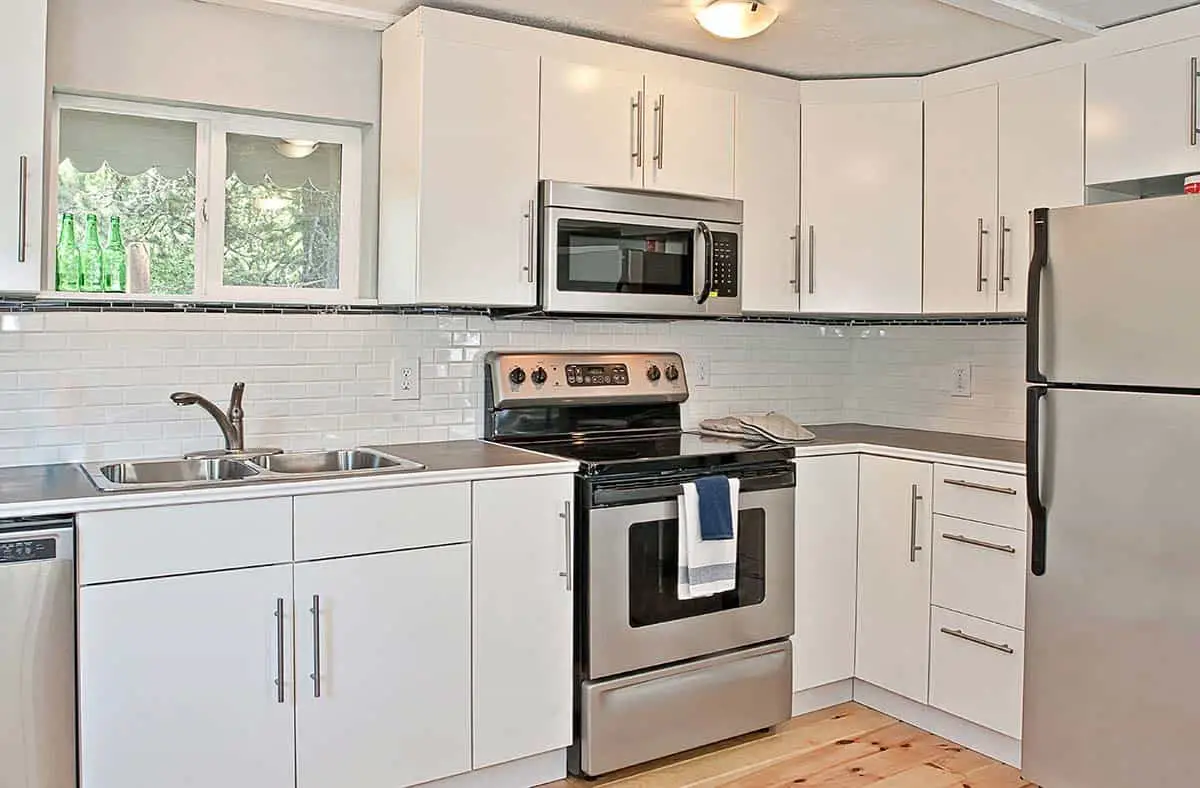Learning how to organize kitchen cabinets is a must for every homeowner. It helps you keep everything in place in a neat and coordinated way. As such, having a step-by-step plan will help you get started organizing your kitchen cabinet.

Steps on How to Organize Kitchen Cabinets
The kitchen is the busiest space in your house, from grabbing ingredients to the clanks of utensils. Because of this, how to organize kitchen cabinets is often a challenging task for many homeowners.
With busy hands, it’s hard to keep track of organizing kitchen cabinets what goes where system.
However, this is totally doable with some time, effort, and creativity in mind. Since we have different preferences, it will take some experimentation to find the perfect setup.
Here are some basic steps to help you get a picture of how you will start how to organize kitchen cabinets:
Come Up with a Plan
The first step in organizing kitchen cabinets that goes where the system is to come up with a smart plan. You can either work on everything at once or separate the task a few cabinets at a time.
Thus, you can lessen the overwhelming feeling of decluttering and item reshuffling depending on the pace you prefer.
Declutter
Perhaps the most important part of the initial preparation, it’s a must to declutter your space before proceeding to organize.
You have to determine which items you don’t need anymore on how to organize kitchen cabinets.
Learn to let go and not hoard things. In this process, you can make cleaning and organizing easier with less stuff. For this step, make sure to empty out the interior completely.
Then, make sure to only keep the things you truly need in your workstation. If you haven’t used something in the cabinet for the past 6 months, ask yourself if you should keep it.
Because often, unused items just add to the clutter and disorder in your space.
Thorough Cleaning
Of course, cleaning is a vital part of how to organize kitchen cabinets.
You don’t want to end up with a dusty and muddy space after organizing. Make sure to clean all the cabinet surfaces, including the corners, sides, and top.
Here are some more notes on cleaning:
- Use a handheld vacuum to get rid of crumbs.
- Wiper the surface with a microfiber cloth and a mixture of water and dish soap.
- Use a disinfecting spray for areas with previous food spills.
Use a Liner
Using a liner for your kitchen cabinet drawers offers a lot of benefits that you may think. It can cover up any stains or imperfections in the drawer surface.
Plus, you can also use it to protect the drawer from future damage or spills. You can easily purchase liners from stores or you can also make one yourself from wrapping paper and transparent contact paper.
It’s best to use a non-adhesive variant so that you can easily remove it if you want to switch it out. Just use double-sided tape to secure the edges and to ensure it doesn’t slide.
Separate Kitchen Items by Zones
Grouping kitchen cabinet items by zones is one the best way how to organize kitchen cabinets. What you need to do for this is to group all similar items in separate zones.
As such, you can easily find things according to their use. It is a functional and surefire way of organizing kitchen cabinets what goes where system.
If you previously have an unorganized kitchen cabinet, then this step will involve a lot of reshuffling.
A helpful tip is to place these zones closest to the area where you frequently use them. Having this system in your kitchen will help you work more quickly and efficiently.
Here are some ideas:
- Food storage zone
- Food preparation zone
- Beverage zone
- Cooking zone
- Baking zone
- Container zone
- Cleaning products zone
Use Bins and Organizers
Besides separating kitchen items by zone, it’s also great to use bins and organizers to keep similar items together.
It will help you keep essential items one grab and pull away. At the same time, it’s also easier to put them back inside.
Keep Accessibility in Mind
Putting accessibly on top of your mind is very crucial on how to organize cabinets in kitchen. That’s why you have to store your kitchen items in smart locations where you can grab and put them away easily.
Make sure to place children’s items at a level where they can access them without adults helping them out. You can also use a double lazy susan to optimize vertical storage space.
Here are some tips on which items should go where:
- Frequently used items: Cabinet front and countertops
- Non-frequently used items: Higher shelves and back of the cabinet
How to Organize Kitchen Cabinets in a Small Kitchen
The task of how to organize cabinets in kitchen is even more challenging in small kitchens. You have to ensure that your kitchen items are stacked and organized properly in an uncluttered way.
As such, how to organize kitchen cabinets in a small kitchen takes even more innovative thinking.
The goal is to make your space look and feel larger and not stuffed. Before diving into specific tips on how to organize kitchen cabinets
Here are some tips on how to organize kitchen cabinets in a small kitchen:
- Make use of opaque bins and containers and label each for items that don’t run out.
- Use clear bins and containers for ingredients and items that run out.
Use Cabinet Shelf Risers
Shelf risers offer extra space in your kitchen cabinet for storing items like cups and mugs. You can also use them for separating different types of plates and bowls and even different variants of spices.
Use Drawer Organizers
Using drawer organizers is a must especially on how to organize kitchen cabinets in a small kitchen.
One of the best ways how to organize cabinets in kitchen and make them look neat and highly organized. It’s also pleasing to the eyes and will not stress you upon opening them.
Here are some of the items you can use:
- Silverware tray
- Wood knife block
- Bamboo drawer dividers
Sideway Stacking
Pots and pans take up a lot of space in the cabinet. That’s why it can be stressful how to store them especially for kitchens with smaller space.
The common go-to is stacking them on top of each other. However, it generates a hassle in pulling them out.
The answer to this problem is installing a cookware rack inside your cabinets. It helps you store your pots and pans sideways, held by wire separators.
It doesn’t only save space but also eases the task of grabbing a pan when you need it.
Install Hooks Inside Your Cabinets
Install hooks on the door and side parts of your cabinet’s interior. This method is helpful for small kitchen spaces since you’re not wasting any space.
You can hang cooking utensils, potholders, and more without making it look clumped. It also helps you keep them outside the cabinet which can make the kitchen space look stuffy.
Utilize Lazy Susans
One of the best ways on how to organize kitchen cabinets in a small kitchen is to utilize lazy Susans.
It’s best for organizing kitchen items on corner cabinets, which have tricky spaces. It keeps spices and bottles organized and easy to access anytime.
Stack Bowls and Tupperware
Unlike pots and pans, the best way to store bowls and Tupperware is by stacking. They stack well together and it saves a lot of space than other ways to store them.
Ways to Organize Kitchen Cabinets: Assigning Items
The best ways to organize kitchen cabinets involve assigning items to specific areas of the cabinet space. Make sure to assess how you use your kitchen cabinet space and how often you use each item inside.
The key here is to keep these items close to the kitchen area where you frequently use them. Assigning items to each kitchen cabinet is one of the most strategic ways to organize kitchen cabinets.
For instance, usually, we only use wine glasses for special occasions compared to drinking glasses that we use regularly.
Thus, you don’t have to place your wine glass in easy-to-reach cabinet spaces, unlike your drinking glasses. Keep this approach in mind on the ways to organize kitchen cabinets.
Make sure to plan which items you will place in the upper and lower cabinets depending on their usage. Below are some important tips on the ways to organize kitchen cabinets:
Upper Cabinets
Here are the kitchen items ideal for storing in upper cabinets:
- Dishes and glasses: Keep dishes and glasses on a drying rack for easy storing.
- Food storage containers: Place food storage containers near the counter space for easy grabbing when you need to store food.
- Food: Try to keep your food in the area above your workstation where you prepare food. It makes them easily accessible during meal preparations.
For kitchens with pantries, make sure to utilize the pantry space first before storing them in kitchen cabinets.
Lower Cabinets
Here are the kitchen items ideal for storing in lower cabinets:
- Pots and pans: Stack your pots and pans sideways using the earlier tip in a lower cabinet near your stove. Storing them vertically helps you maximize space and makes it easier to reach them once you need to cook.
- Cutting boards and bowls: For easy storing and access, keep cutting boards and bowls in lower cabinets near the dishwasher or drying rack.
- Appliances: Since appliances can be heavy, store them below your primary workstation for easy pulling out. If you use it frequently, you can consider placing it on the countertop to ease the hassle of pulling out and putting back.
- Cleaning supplies: The best area to store cleaning supplies for your kitchen is in a lower cabinet under the kitchen sink. It will help reduce the risk of leaks and spills and the cleaning process in case it happens.
Make sure not to store these cleaning supplies along with food and spices.
Mastering Kitchen Cabinet Storage & Organization
There are many ways how to organize kitchen cabinets. While you may find it intimidating to start, the key is to have systemic and innovative thinking.
Once you take the first step, you’ll find that you can make great use of your kitchen cabinet space.
Remember: keep it neat, simple, and organized at all times. Without proper maintenance, your hard work will go to waste.
We hope these tips helped you in starting your journey towards creating an organized kitchen cabinet system.
